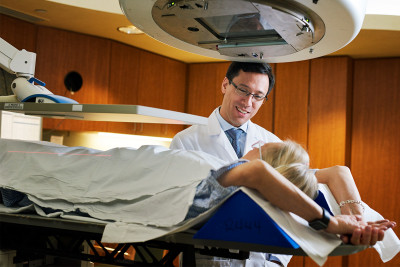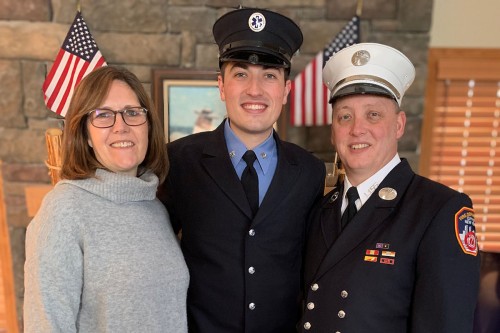
Radiation oncologist Andreas Rimner delivers radiation to lung cancer patients using a GPS-type approach that tracks the tumor’s precise location at all times.
Radiation therapy for lung cancer uses high-energy beams called x-rays to destroy cancer cells by damaging their DNA. It’s very effective at controlling or eliminating tumors at specific sites in the body.
The treatment can be given to cure patients whose lung cancers are confined to the chest but cannot be removed surgically. Using the most-advanced technologies, we can now deliver powerful doses of radiation directly to your tumor with exquisite precision. The approaches we use can reduce the number of sessions required for radiation treatment in comparison with more conventional approaches, while also limiting the risk of side effects.
Radiation therapy can also be used as a palliative measure to improve quality of life among patients whose disease does not respond to surgery or chemotherapy.
Types of Radiation Therapy
Intensity-Modulated Radiation Therapy
Our radiation oncologists pioneered the use of intensity-modulated radiation therapy (IMRT) to treat lung cancer. Following a CT scan that maps the tumor in 3-D, IMRT uses sophisticated computer programs to calculate and deliver variable doses of radiation directly to the tumor from different angles. This technology targets the tumor while sparing the healthy tissue that surrounds it, enhancing your radiation oncologist’s ability to administer a lethal dose of radiation to a lung tumor and increasing your chance for cure.
Some people with lung cancer may be treated with a specialized form of IMRT called image-guided radiation therapy (IGRT). IGRT involves the use of sophisticated imaging tests to verify the position of the patient and the location of the tumor prior to and during the delivery of the treatment. Imaging tests play a crucial role in helping doctors to accurately plan and effectively deliver radiation therapy.
Because the traditional method of using a CT scan to target the tumor can sometimes damage normal tissue containing no cancer cells, we have incorporated PET imaging into the treatment planning process. PET technology allows our doctors to more precisely — and safely — target the tissue containing cancer cells and avoid harming healthy tissue.
IGRT requires no anesthesia and side effects are less likely than with traditional methods.
We treat approximately 400 patients with non-small cell lung cancer each year using IGRT to the chest as well for lung cancer that has spread to other areas of the body.
MSK Precise™
Many people with non-small cell lung cancer whose tumors are small and confined to the lung can benefit from a treatment called MSK PreciseTM. It is also known as hypofractionated radiation therapy. The dose of radiation that is given with each treatment is larger than in standard radiation therapy, but it is given in fewer treatments over a shorter period of time.
MSK Precise uses innovative imaging combined with a sophisticated computer system to deliver high doses of radiation to lung tumors. It is accurate within a few millimeters. MSK Precise even takes into account how a tumor moves when people breathe. This treatment can be effective for people who are not able to have surgery or when used in combination with chemotherapy, targeted therapies, or immunotherapy. For safety while using the higher radiation doses, our radiation oncologists do 3-D modeling of the tumor. This provides the tumor’s location at all times to ensure that the radiation is precisely targeted.
Proton Therapy
For some cases of lung cancer, our radiation oncologists can use proton therapy, an advanced form of radiation therapy, to deliver high doses of radiation to tumors that may be resistant to conventional forms while minimizing exposure to the surrounding healthy tissues. Proton therapy directs its cancer-fighting energy to precise locations within the body, allowing our doctors to deliver the necessary dose to the tumor — maximizing the chance of destroying it — while simultaneously lowering the dose to normal tissues and thereby reducing the risk of treatment-related side effects.
Currently, this cutting-edge technology is available at only 14 locations in the United States.
Brachytherapy
Some people with lung cancer may be candidates for intraoperative radiation therapy, a brachytherapy procedure in which we deliver radiation therapy during surgery in order to help decrease the risk of cancer returning after treatment (recurring). We are also able to deliver high doses of radiation to the airways using a specialized approach called endobronchial brachytherapy. This localized form of radiation therapy may be useful in selected patients whose cancer has returned in the larger airways.
Palliative Radiation Therapy
While radiation therapy is generally not used to treat cancer that has metastasized (spread) to the second lung or to other parts of the body, many patients receive radiation to treat symptoms that are caused by metastases. The goal of these treatments is to improve the quality of life for patients who are not candidates for surgery or radiation therapy.
Clinical Trials in Radiation Oncology
For some patients, the best strategy may be to enroll in a clinical trial that evaluates new radiation techniques or combinations of surgery, chemotherapy, and radiation therapy.
Many of our clinical trials aim to further improve the precision of our imaging and radiation delivery techniques. Our goal is to minimize damage to surrounding normal tissues and maximize the effectiveness of the radiation treatment to the tumor.
We are also studying several targeted drugs in combination with radiation therapy to understand how radiation therapy and the immune system interact to fight cancer.
Radiation Therapy for Non-Small Cell Lung Cancer
Radiation therapy for early-stage non-small cell lung cancer, which consists of a single small nodule in the lung without any spread to nearby lymph nodes, is typically given as stereotactic body radiation therapy (SBRT). SBRT has been highly successful in treating small lung lesions with excellent long-term chances to eradicate them. It is therefore the standard of care for patients who cannot be treated surgically.
If you have advanced non-small cell lung cancer that has spread to your lymph nodes but is still confined to your chest, and you cannot be treated surgically either because of your tumor’s location or because of your health, we may recommend radiation therapy. It’s ideally given with chemotherapy administered either at the same time or before or after radiation therapy. These treatments typically last about six weeks, with five daily treatments per week.
If you have advanced non-small cell lung cancer that is confined to the chest and have your tumor surgically removed, you may be treated with a five-to-six-week course of radiation therapy before or after your surgery depending on your specific situation.
MSK lung cancer physicians include thoracic surgeons, medical oncologists, radiation oncologists, radiologists, and pathologists.
Radiation Therapy for Small Cell Lung Cancer
At MSK, the approach your doctors recommend will depend on the stage of your disease.
People with limited-stage small cell lung cancer confined to the chest simultaneously receive a combination of chemotherapy and radiation therapy to shrink the tumor. Radiation therapy for limited-stage small cell lung cancer can be administered either once or twice a day. The treatment course lasts between three and seven weeks.
People with extensive-stage cancer typically receive chemotherapy only, but radiation therapy can be given to help improve symptoms such as pain, headaches, or weakness from brain lesions. The treatment course typically lasts two to three weeks, with five daily treatments per week.
In many people, small cell lung cancer metastasizes (spreads) to the brain, even after a positive response to initial treatments. Prophylactic (preventive) cranial irradiation is a whole-brain radiation therapy that can help prevent the development of brain metastases and improve survival in patients with limited- and extensive-stage small cell lung cancer who show a response to treatment with first-line chemotherapy or chemotherapy and radiation therapy.




